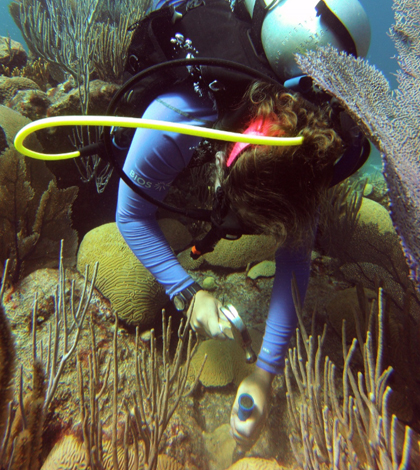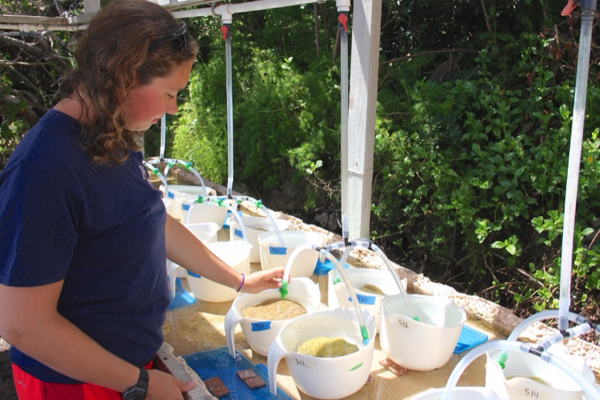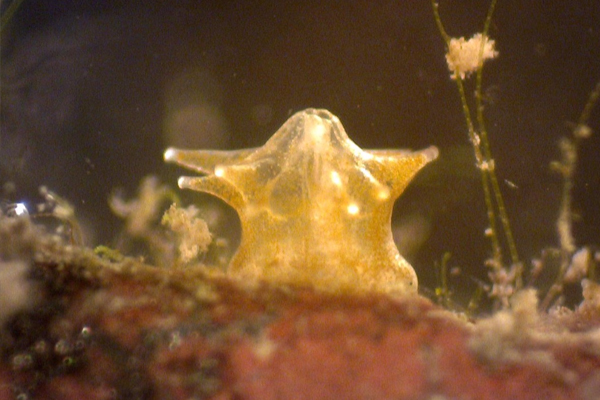Clark U. Juvenile Coral Research May Help Save Threatened Coral Reefs

Hannah Reich collects corals off a shallow reef in Bermuda. (Credit: Andreas Rateray)
Coral reefs are renowned for their beauty, biodiversity and ability to provide critical habitat for an estimated 25 percent of the world’s fish, despite covering only about 1 percent of the ocean. Unfortunately, coral reefs are also some of the most sensitive habitats on Earth. Ongoing climate change has catalyzed unprecedented stress on the world’s coral reef habitats. The stress of rising global temperatures has resulted in bleaching or even death of many coral reefs all over the world.
But Hannah Reich, Clark University graduate student in biology and Bermuda Institute of Ocean Sciences research intern, along with a team of researchers led by Gretchen Goodbody-Gringley (BIOS), hopes her research may one day help reverse the global trend for coral reefs. Reich and her team are investigating refugia, hoping to not only support remaining coral reefs with their research, but perhaps also discover how to bring back reefs that are currently damaged or seem lost forever.
For Reich, a key to reversing the negative trends for coral lies in researching juvenile coral. She hopes to answer questions about whether mesophotic (deeper water) juvenile corals are able to survive on shallow reefs. If viable, mesophotic taxa could possibly replenish declining nearby shallow counterparts when harsh conditions on shallow reefs subside. In other words, she is investigating whether juvenile coral could potentially be transplanted and ultimately bring dead or dying coral reefs back to life.
“Corals in shallow water are declining in many places,” says Reich. But coral decline, while potentially harmful for all the species that depend on coral reef habitat, is not necessarily permanent. “Although stressed corals can release their algal symbionts, which ultimately can cause bleaching and/or coral death, if the harsh climatic conditions recede, the algal symbionts can be recaptured.” In addition to that possibility, Reich says, “there’s the Deep Reef Refugia Hypothesis, which says that when harsh conditions on shallow reefs subside, mesophotic corals may replenish the declining shallow taxa.”

Hannah Reich checks the waterflow for containers holding adult Porites astreoides corals. (Credit: Lara Funk)
In order to learn more about juvenile corals and determine potential coral recovery strategies, Goodbody-Gringley, Reich and coworkers are currently involved in a study of adult and juvenile corals and their algal symbionts across a depth gradient, to look at whether the algal symbionts play a role in juvenile coral survivorship. More specifically, they are studying how mesophotic juveniles might survive on shallow reefs by monitoring spawning, settlement, growth and compositions of algal symbionts.
The depth gradient experiments include shallow and mesophotic corals, which occur at about 0 to 30 meters and 30 to 150 meters, respectively. The mesophotic region is characterized by low light availability and the presence of soft corals, sponges and algae. Little is known about it, as it is beyond the range of conventional scuba diving.
Reich’s study has focused on the Mustard Hill coral, Porites astreoides, a common reef-building coral in Bermuda’s waters where Reich has done much of her research.
There were many restrictions on collecting corals for further experiments in the lab on land. “We obtained collection permits from the government of Bermuda before sampling for adult corals,” Reich recalls.
The lab experiments required bringing adult corals from shallow and mesophotic reefs to the lab, monitoring their spawning events, collecting the coral larvae and monitoring their settlement to tiles. Finally the juvenile coral were transported back to the reef to see whether they would survive.
The first step of the process was placing the adults in large jugs with handles. The jugs were tilted so that water would flow through the handle and into a larval collection container placed underneath the jug handle. The collection container had a mesh bottom in order to collect larvae but allow for water flow. The terra cotta tiles used as a substrate for larval settlement were pre-conditioned by being left on the reefs to soak in the seawater, microbes, minerals and any natural organisms common to the coral’s natural habitat.
The larvae were placed in Tupperware containers with an equal number of larvae and tiles in each container for one week. To score for settlement, tiles were thoroughly examined under the microscope for metamorphosed planula (juvenile corals). Circles were drawn with pencil and recorded on the areas where the larvae seemed to be successfully colonizing the tiles. Tiles with juvenile corals were packed in egg crates and relocated to coral reefs for a month of monitoring growth. After a month, pictures were taken of the juveniles to compare pre- and post-transplant growth.

Juvenile Porites astreoides that is two-weeks old and has successfully settled onto terra cotta tile. Image captured with a pupil camera. (Credit: Kevin Wong)
Then, the whole process was repeated but the juveniles were kept at BIOS and monitored in the lab biweekly for two months. Survivorship was monitored: how many juveniles and their size were noted. This was done using imageJ analysis, taking pictures with sizing tools and using a pupil camera.
The first set of research questions Goodbody-Gringley, Reich and colleagues set out to answer were regarding juvenile coral spawning, growth and survivorship. The second set of questions focused on the coral’s algal symbionts, which cannot be distinguished visually.
There are nine algal symbiont types. In order to distinguish them, Reich is using the internal transcribed spacer 2 (ITS2), a conserved gene which is commonly used for species identification. First, tissue was removed from a portion of the coral with a water pik, then DNA was extracted, which was amplified using PCR (polymerase chain reaction).
The PCR products will be used to identify which group of symbionts are found in the corals based on the ITS2 DNA sequences. A Basic Local Alignment Search Tool will be used to identify the purified and amplified DNA and determine which algal symbionts were present in the corals.
The experiments are still in progress and Reich does not yet want to reveal results. “Something we do know from previous research, however, is that there are nine genetically distinguished clades, or algal symbiont types, named A-I. Clade D has been found to be a thermo-tolerant symbiont. Studies have found that symbiont composition can enhance coral resilience to climate change. Corals harboring clade-D symbionts may have the best shot at survival,” Reich explains.
Lastly, Reich wants to emphasize that she has received a lot of support from many people in her research, especially crediting the labs of Gretchen Goodbody-Gringley at BIOS and Deborah Robertson at Clark University. She also thanks Clark for giving her financial support through her Gellar Award, as well as financial support from the PADI Foundation, and BIOS (both Grant-In-Aid and educational funds).
“Everyone who gets a chance should take a dive (or snorkel) to see coral reefs,” Reich enthuses. “You really won’t believe how beautiful they are once you see them in person. They are my passion. I hope to start my own coral research lab one day and transfer what I have learned about our coral reefs to future generations.”
Top image: Hannah Reich collects corals off a shallow reef in Bermuda. (Credit: Andreas Rateray)





0 comments